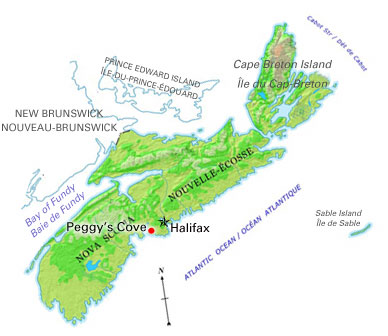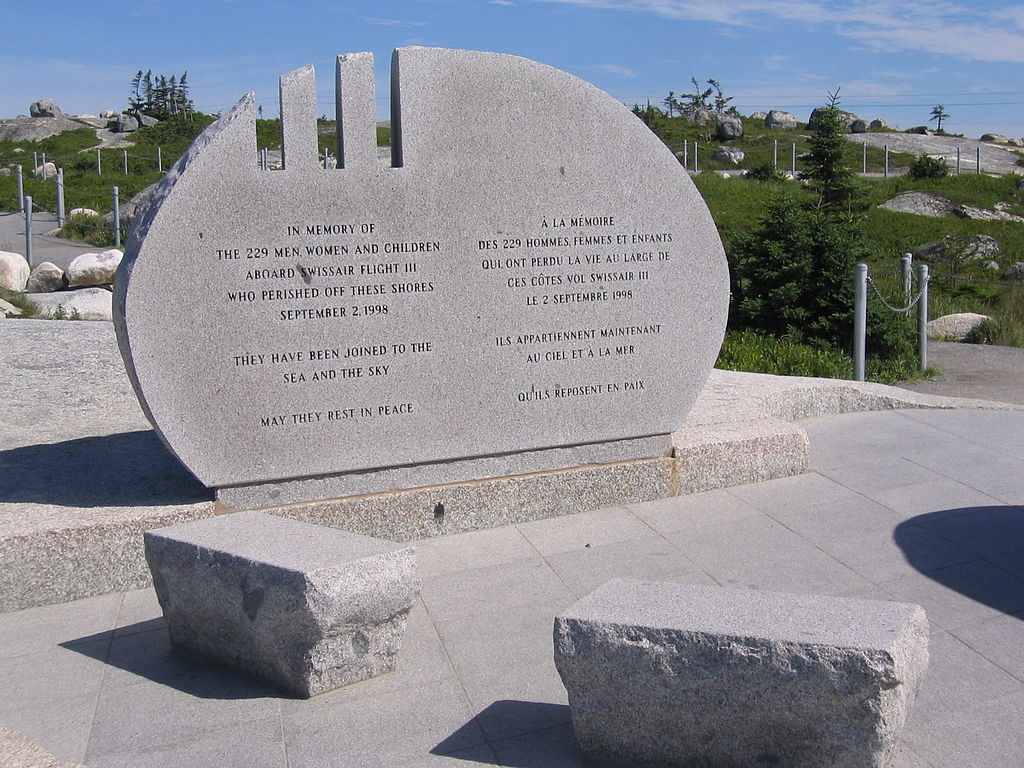
“UN Shuttle”
Swissair 111 departed New York’s John F. Kennedy International Airport at 8:18 p.m. Eastern Time on the evening of 2 September 1998, en route to Geneva, Switzerland. On board the McDonnell Douglas MD-11 tri-engine jet were 215 passengers and a crew of 14. This regularly scheduled flight was popular with United Nations officials, researchers and scientists and was known as the “UN Shuttle.”
Some of the passengers were leaders in their fields. Jonathan Mann, a pioneer in the global campaign against AIDS, his wife Mary Lou Clements-Mann, also a world renowned AIDS researcher and vaccine scientist, Pierre Babolat, head of the French sports equipment maker Babolat, and Pierce Gerety, a senior official with the UN Refugee Agency, were some of the notable passengers travelling to Geneva. The plane also routinely carried valuables to and from the financial capitals of the United States and Switzerland, and this flight was no different. In the cargo hold that night were millions of dollars of banknotes, jewellery and diamonds, as well as a painting by Pablo Picasso.
Smoke in the Cockpit
About 53 minutes into the flight, with the plane now in Canadian airspace, the pilots noticed an abnormal odour in the cockpit along with a trace of smoke. The smoke quickly dissipated, but when it reappeared a couple of minutes later, they decided to take action. At 10:14 p.m. Atlantic Time (AT), the pilots broadcast a “pan pan” message to air traffic controllers in Moncton, New Brunswick and requested permission to divert to the nearest airport. A “pan pan” message indicates that the pilots believe there is a serious problem but one that is not a full emergency.
The Swissair pilots suggested landing in Boston, but the controller offered Halifax International Airport as an alternative, which was 110 nautical miles closer. The pilots quickly agreed.
As the pilots went through procedural checklists to try to determine the cause of the smoke, they discussed the need to dump fuel before attempting to land at Halifax. With a full fuel tank the plane was heavier than what the manufacturer suggested was the maximum weight to land safely. At 10:22 p.m. AT, the plane turned south, heading to St. Margarets Bay, Nova Scotia, to prepare to dump fuel. However, conditions in the cockpit deteriorated quickly. Just two minutes later, the plane’s autopilot system shut down. Then, at 10:24 p.m. AT both pilots simultaneously declared a full emergency. Moments later, air traffic controllers tried to contact the crew, but received no response.

Crash
Just before 10:30 p.m. local time, people living in the small communities surrounding St. Margarets Bay reported seeing a plane flying overhead at low altitude. The sounds of the engines rattled homes and windows. At 10:31 p.m., witnesses reported hearing a sound resembling a loud thunderclap. Swissair 111 crashed into the ocean about five nautical miles southwest of Peggy’s Cove — a world-renowned Nova Scotia tourist destination that attracts thousands of visitors each year.
The events that led to the disaster — from the initial discovery of smoke in the cockpit to the plane crashing into the ocean — took less than 20 minutes to unfold.
Investigators later found that in the final six minutes, after the last communication from the flight, the plane suffered a catastrophic failure of its major electrical systems. Flying manually, with no instruments on a cloud-covered night, with smoke filling the cockpit, the pilots lost all orientation with the horizon, according to investigators. The plane hit the water with its nose down at 20 degrees and in a 60-degree bank to the right — an impact that shattered the plane and killed all on board instantly.
Scrutiny of Pilots
After the crash, some aviation experts suggested the pilots, Captain Urs Zimmerman and First Officer Stephen Lowe, both veteran pilots with hundreds of hours experience flying, should not have altered their course to dump fuel, but should have flown directly to Halifax to try to land the heavily laden plane. However, Swissair said that in subsequent simulations of the flight, they could not land the plane safely under similar conditions. Investigators for Canada’s Transportation Safety Board agreed, concluding that even if the plane had flown directly to Halifax, “it would have been impossible for the pilots to continue maintaining control of the aircraft for the amount of time necessary to reach the airport and complete a safe landing.”
Search Operations
Immediately after the crash, a massive search, later dubbed “Operation Persistence” began. First on the scene were private fishing boats and pleasure craft from the surrounding villages, many of them volunteer members of the Canadian Coast Guard Auxiliary. They were soon joined by government vessels and helicopters from the Royal Canadian Navy, Coast Guard, Fisheries and the RCMP.
The scene they discovered was horrific. The massive debris field was littered with pieces of aircraft, personal effects and human remains. The force of the impact was so severe, only one body was found intact.
Over the next hours and days, the human remains recovered were transferred to a morgue set up for the disaster at Canadian Forces Base (CFB) Shearwater. Medical officers had to use a combination of dental records, DNA, fingerprints and forensic radiography to identify the remains. The work was so difficult it took until December 1998 to identify the remains of all 229 passengers.
Salvage
The effort to recover the wreckage took much longer. The undersea wreckage site was first located when the Navy submarine HMCS Okanagan homed in on the underwater locator beacons from the flight recorders. Divers were able to recover both the Flight Data and the Cockpit Voice recorders. However, investigators determined both stopped recording when the electrical systems failed, five-and-a-half minutes before impact.
Over the next 15 months, searchers used a number of salvage vessels, heavy-lift barges and even scallop draggers to scour the ocean floor and recover the wreckage. In the end, they recovered almost 2 million pieces — some as small as a one dollar coin — totalling 98 per cent of the wreckage. Salvaged material was brought to hangers in CFB Shearwater where it was cleaned and sorted. A full-scale mock-up of the front section of the aircraft was built and more than 350 investigators and aviation experts from around the world reconstructed large portions of the plane. The investigation was led by the Transportation Safety Board of Canada (TSB).
Investigation Findings and Recommendations
From the beginning, investigators concentrated on the extensive wiring in the ceiling above the cockpit. Investigators found several wire pieces that exhibited melted copper consistent with electrical arcing damage. They concluded that sparks from faulty wiring ignited adjacent sound-dampening insulation that was coated with a highly flammable material called metallized polyethylene terephthalate (MPET). There was speculation that the arcing came from wiring from the plane’s inflight entertainment system, but investigators were unable to say conclusively that this was where it started.
They also found there was no fire detection system in the area above the cockpit, making it difficult for the crew to determine the source of the fire.
The investigation took four-and-a-half years to complete and cost $57 million — the most expensive accident investigation in Canadian aviation history. In the course of the probe, the TSB issued 23 safety recommendations. As a result, MPET insulation was ordered removed from all aircraft. The TSB also called for tougher flammability standards for all materials used in airplanes, and more stringent certification standards for all electrical wires.
Other recommendations ranged from installing backup power for flight data and voice recorders, to revising pilot emergency checklists to put more emphasis on landing as quickly as possible.
In 2017, Tom Juby, a retired RCMP officer, published a book alleging that investigators had ignored evidence that the crash might not have been accidental and might have been caused by a bomb in the cargo area. However, there has been no conclusive evidence to support that claim. According to the TSB, the RCMP “found no evidence to support the involvement of any explosive or incendiary device, or other criminal act in the initiation of the in-flight fire.”
Memorials
A week after the crash, an outdoor memorial service was held at an elementary school near Peggy’s Cove. It was attended by dignitaries from Switzerland, Canada and the US, along with hundreds of grieving family members who traveled to Nova Scotia to gather information about their loved ones and to see where they died. Another memorial service was held one year later in Halifax. Many family members of the victims expressed gratitude for the efforts of the hundreds of volunteers and first responders involved in the search, along with the counsellors and volunteers who aided victims’ families while in Nova Scotia.
In April 1999, the government of Nova Scotia announced plans for two permanent memorial sites to commemorate the victims of Swissair 111. One is adjacent to Peggy’s Cove, overlooking the crash site. A second, larger memorial sits across St. Margarets Bay in the village of Bayswater. The unidentified remains of the passengers and crew are buried at this site.


 Share on Facebook
Share on Facebook Share on X
Share on X Share by Email
Share by Email Share on Google Classroom
Share on Google Classroom

